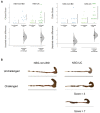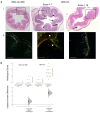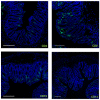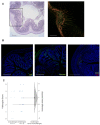Humanized NSG Mouse Models as a Preclinical Tool for Translational Research in Inflammatory Bowel Diseases
- PMID: 37569722
- PMCID: PMC10418464
- DOI: 10.3390/ijms241512348
Humanized NSG Mouse Models as a Preclinical Tool for Translational Research in Inflammatory Bowel Diseases
Abstract
The development of animal models reflecting the pathologies of ulcerative colitis (UC) and Crohn's disease (CD) remains a major challenge. The NOD/SCID/IL2rγnull (NSG) mouse strain, which is immune-compromised, tolerates the engraftment of human peripheral blood mononuclear cells (PBMC) derived from patients with UC (NSG-UC) or CD (NSG-CD). This offers the opportunity to examine the impact of individual immunological background on the development of pathophysiological manifestations. When challenged with ethanol, NSG-UC mice exhibited a strong pro-inflammatory response, including the development of edemas, influx of human T cells, B cells and monocytes into the mucosa and submucosa, and elevated expression of the inflammatory markers CRP and CCL-7. Fibrotic alterations were characterized by an influx of fibroblasts and a thickening of the muscularis mucosae. In contrast, the development of pathological manifestations in NSG-CD mice developed without challenge and was signified by extensive collagen deposition between the muscularis propria and muscularis mucosae, as observed in the areas of strictures in CD patients. Vimentin-expressing fibroblasts supplanting colonic crypts and elevated expression of HGF and TGFß corroborated the remodeling phenotype. In summary, the NSG-UC and NSG-CD models partially reflect these human diseases and are powerful tools to examine the mechanism underlying the inflammatory processes in UC and CD.
Keywords: Crohn’s disease; IBD; NOD/SCID/IL2rγnull; NSG; animal models; immune-deficient; inflammatory bowel disease; mouse models; ulcerative colitis.
Conflict of interest statement
The authors declare no conflict of interest.
Figures










Similar articles
-
NOD/scid IL-2Rγnull mice reconstituted with peripheral blood mononuclear cells from patients with Crohn's disease reflect the human pathological phenotype.Immun Inflamm Dis. 2021 Dec;9(4):1631-1647. doi: 10.1002/iid3.516. Epub 2021 Sep 9. Immun Inflamm Dis. 2021. PMID: 34499803 Free PMC article.
-
The Combination of Patient Profiling and Preclinical Studies in a Mouse Model Based on NOD/Scid IL2Rγ null Mice Reconstituted With Peripheral Blood Mononuclear Cells From Patients With Ulcerative Colitis May Lead to Stratification of Patients for Treatment With Adalimumab.Inflamm Bowel Dis. 2020 Mar 4;26(4):557-569. doi: 10.1093/ibd/izz284. Inflamm Bowel Dis. 2020. PMID: 31782956 Free PMC article.
-
Design and validation of a disease network of inflammatory processes in the NSG-UC mouse model.J Transl Med. 2017 Dec 28;15(1):265. doi: 10.1186/s12967-017-1368-4. J Transl Med. 2017. PMID: 29282132 Free PMC article.
-
Differentiating ulcerative colitis from Crohn disease in children and young adults: report of a working group of the North American Society for Pediatric Gastroenterology, Hepatology, and Nutrition and the Crohn's and Colitis Foundation of America.J Pediatr Gastroenterol Nutr. 2007 May;44(5):653-74. doi: 10.1097/MPG.0b013e31805563f3. J Pediatr Gastroenterol Nutr. 2007. PMID: 17460505
-
Inflammatory bowel diseases: controversies in the use of diagnostic procedures.Dig Dis. 2009;27(3):269-77. doi: 10.1159/000228560. Epub 2009 Sep 24. Dig Dis. 2009. PMID: 19786751 Review.
Cited by
-
Preclinical proof of principle for orally delivered Th17 antagonist miniproteins.Cell. 2024 Aug 8;187(16):4305-4317.e18. doi: 10.1016/j.cell.2024.05.052. Epub 2024 Jun 26. Cell. 2024. PMID: 38936360 Free PMC article.
-
NOD/Scid IL2Rγnull Mice Reconstituted with PBMCs from Patients with Atopic Dermatitis or Psoriasis Vulgaris Reflect the Respective Phenotype.JID Innov. 2024 Feb 3;4(3):100268. doi: 10.1016/j.xjidi.2024.100268. eCollection 2024 May. JID Innov. 2024. PMID: 38736522 Free PMC article.
-
Can Humanized Immune System Mouse and Rat Models Accelerate the Development of Cytomegalovirus-Based Vaccines Against Infectious Diseases and Cancers?Int J Mol Sci. 2025 Mar 27;26(7):3082. doi: 10.3390/ijms26073082. Int J Mol Sci. 2025. PMID: 40243710 Free PMC article. Review.
References
-
- Ng S.C., Shi H.Y., Hamidi N., Underwood F.E., Tang W., Benchimol E.I., Panaccione R., Ghosh S., Wu J.C.Y., Chan F.K.L., et al. Worldwide incidence and prevalence of inflammatory bowel disease in the 21st century: A systematic review of population-based studies. Lancet. 2017;390:2769–2778. doi: 10.1016/S0140-6736(17)32448-0. - DOI - PubMed
-
- Molodecky N.A., Soon I.S., Rabi D.M., Ghali W.A., Ferris M., Chernoff G., Benchimol E.I., Panaccione R., Ghosh S., Barkema H.W., et al. Increasing incidence and prevalence of the inflammatory bowel diseases with time, based on systematic review. Gastroenterology. 2012;142:46–54.e42. doi: 10.1053/j.gastro.2011.10.001. - DOI - PubMed
MeSH terms
Grants and funding
LinkOut - more resources
Full Text Sources
Medical
Research Materials
Miscellaneous

